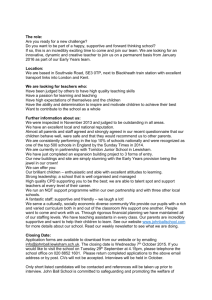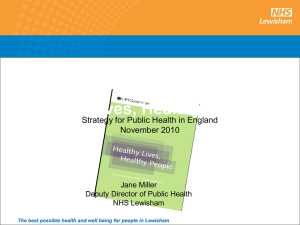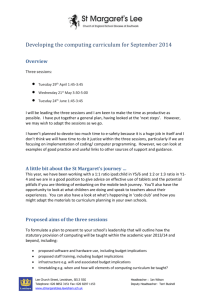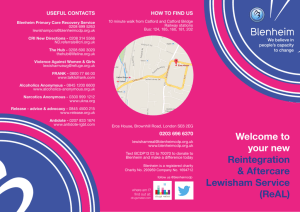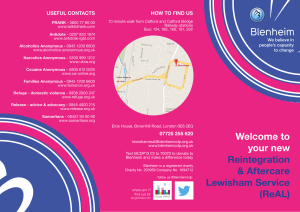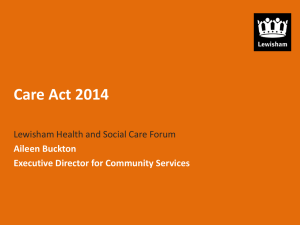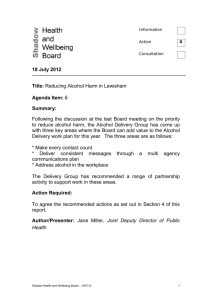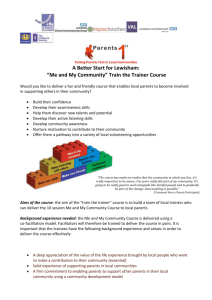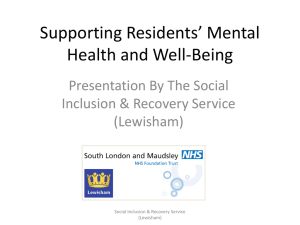Minutes of the last meeting - Lewisham Strategic Partnership
advertisement
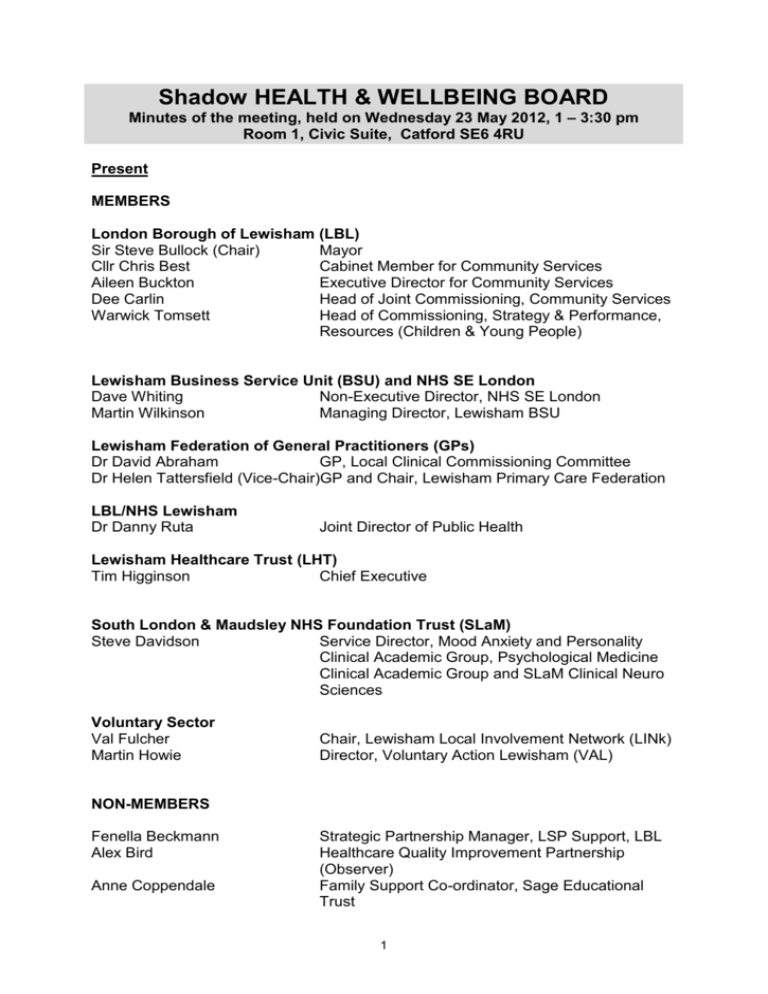
Shadow HEALTH & WELLBEING BOARD Minutes of the meeting, held on Wednesday 23 May 2012, 1 – 3:30 pm Room 1, Civic Suite, Catford SE6 4RU Present MEMBERS London Borough of Lewisham (LBL) Sir Steve Bullock (Chair) Mayor Cllr Chris Best Cabinet Member for Community Services Aileen Buckton Executive Director for Community Services Dee Carlin Head of Joint Commissioning, Community Services Warwick Tomsett Head of Commissioning, Strategy & Performance, Resources (Children & Young People) Lewisham Business Service Unit (BSU) and NHS SE London Dave Whiting Non-Executive Director, NHS SE London Martin Wilkinson Managing Director, Lewisham BSU Lewisham Federation of General Practitioners (GPs) Dr David Abraham GP, Local Clinical Commissioning Committee Dr Helen Tattersfield (Vice-Chair)GP and Chair, Lewisham Primary Care Federation LBL/NHS Lewisham Dr Danny Ruta Joint Director of Public Health Lewisham Healthcare Trust (LHT) Tim Higginson Chief Executive South London & Maudsley NHS Foundation Trust (SLaM) Steve Davidson Service Director, Mood Anxiety and Personality Clinical Academic Group, Psychological Medicine Clinical Academic Group and SLaM Clinical Neuro Sciences Voluntary Sector Val Fulcher Martin Howie Chair, Lewisham Local Involvement Network (LINk) Director, Voluntary Action Lewisham (VAL) NON-MEMBERS Fenella Beckmann Alex Bird Anne Coppendale Strategic Partnership Manager, LSP Support, LBL Healthcare Quality Improvement Partnership (Observer) Family Support Co-ordinator, Sage Educational Trust 1 Thomas Cornwallis Co-ordinator, Hidden Harm, Drug & Alcohol Action Team, Community Services, LBL Mark Drinkwater Health Inequalities & Social Care Officer, VAL Lisa Fannon Project Manager, Talking about Training, NHS Lewisham Fiona Kirkman Service Manager, Prevention & Inclusion, Supporting People, Community Services, LBL Ed Knowles Service Manager, Strategy, Community Services, LBL Garry Madams DPPO Officer, Metropolitan Police, Lewisham Dr Pamela Martin GP, Queens Road Practice, Alcohol lead Jane Miller Joint Deputy Director of Public Health, LBL/NHS Lewisham Katrina McCormick Joint Deputy Director of Public Health, LBL/NHS Lewisham Dr Petula Peters Consultation & Research Officer, Community Services, LBL Maria Cooper Gomez Alcohol Hospital Liaison Officer, New Directions, CRI Geeta Subramanian-Money Head of Crime Reduction & Supporting People, Community Services, LBL Sarah Wainer Head of Strategy & Performance, Community Services, LBL Kalyan DasGupta (Clerk) Assistant Policy Officer, Community Services, LBL Apologies Dr Simon Parton Frankie Sulke GP, Local Medical Committee (LMC) Executive Director for Children & Young People, LBL 1. Welcome & Introductions (Mayor Sir Steve Bullock) The Chair welcomed members to the meeting and attendees introduced themselves. Apologies were recorded. The Chair informed attendees that, since the Board’s last meeting, the Health & Social Care Bill had become an Act. He reminded them that the Shadow Health & Wellbeing Board would at some point come to an end and ther statutory Health & Wellbeing Board would be introdcued. In this context, the Chair felt that the Board might benefit from re-visiting its tasks for the remaining period (between now and then). The Chair explained that there are five components to the Board’s mission that it needs to focus on taking forward by April 2013: : The delivery of the Joint Strategic Needs Assessment (JSNA); Formulating the Health & Wellbeing Strategy (HWBS); Supporting the etsbalishment of Lewisham Clinical Commissioning Group (CCG); Supporting the estbalishment of a local HealthWatch; and Transferring public health functions to local government. 2 Members were aksed to reflect on the Shadow Board and consider how best it could: Add value Making a real difference in the borough and Involve the right partners and stakeholders. 2. Minutes of the last meeting (1 February 2012) Accuracy: The minutes of the last meeting were agreed as an accurate record of the proceedings. Matters Arising: There were no matters arising. 3. Joint Strategic Needs Assessment (JSNA) (Danny Ruta) Danny took the Board through the new web-based JSNA, highlighting the following points: The production of a joint strategic needs assessment of the health and social care needs of the local population (including the needs of children and young people), otherwise known as a 'JSNA', has been a statutory duty on PCTs and upper tier local authorities since 2007. The new Health and Social Care Act 2012 now places a statutory duty on Clinical Commissioning Groups, the Local Authority and the NHS Commissioning Board, to jointly produce and publish a JSNA. The new legislation also places a duty on the Health and Wellbeing Board to produce and publish a Health and Wellbeing Strategy for meeting the needs identified in their JSNA. The new Act goes further still; it requires the local authority, clinical commissioning groups, and NHS Commissioning Board, when exercising 'any of its functions', to have regard to the JSNA findings and the Health and Wellbeing Strategy. Moreover, these bodies, through the Health and Wellbeing Board are also required to 'sign off' any commissioning plans, and have a duty to give their opinion to the NHS Commissioning Board, and ultimately to the Secretary of State, on how well they think those plans align with their local Health and Wellbeing Strategy. In each local authority area it is the Health and Wellbeing Board that will be responsible for overseeing both the JSNA process and the Health and Wellbeing Strategy. The Lewisham JSNA process and website Draft guidance on JSNAs and joint Health and Wellbeing strategies was published in January 2012. The following key recommendations were made: 3 They should be strategic and must take account of the current and future health and social care needs of the entire population; Real gains can be made if Health and Wellbeing Boards look beyond needs to examine how local assets including the local community itself can be used to meet identified needs; JSNAs and joint Health and Wellbeing strategies are key to understanding inequalities in the local area and the factors that influence them, such as poor housing, worklessness or crime; There should be a focus on the things that can be done together; Joint Health and Wellbeing strategies should prioritise the issues requiring the greatest attention; they will focus on key issues that make the biggest difference. Danny explained that a new JSNA process was implemented in 2011 to support the work of the Council and health partners. This included a standardised process for prioritising the topics on which needs assessments should be undertaken, for completion of the assessments, and for ensuring that these are translated, where appropriate, into planning and commissioning activity. The completed assessments are available to all interested parties via an interactive website (www.lewishamjsna.org.uk). In addition to needs assessments on specific topics such as alcohol, the website also contains a wealth of concise and accessible sociodemographic information, and a comprehensive public health information portal containing public health data from a wide range of trusted sources. These data can be freely downloaded. The Board was informed that the JSNA process will continue on an ongoing basis to prioritise topics for needs assessment, and to publish the findings and recommendations of these assessments to the JSNA website, where they can be accessed by everybody. Danny then gave a presentation, providing a brief online guided tour of the website, using the example of alcohol. Members were requested to be aware of the JSNA website and to promote it within their respective organisations and networks. The discussion highlighted the following points: It will be improtant to ensure that users can use the JSNA to drill down on information in order to relate it clearly to service planning, etc. Data “by practice” or “by ward” can already be accessed, but this can be made more detailed in due course. A discussion is also needed to decide how to load the data that HealthWatch has collected onto this website. Once SHWB approves the website in its current form, a marketing plan can be devised and the website publicised more formally, for example to schools. 4 The front page of the website would benefit from a regular refresh and perhaps the insertion of a Breaking News section. A paper version - probabaly an annual, high-level summary - of the website would be useful. It is conceivable that the website’s title (“JSNA”) might need to be reviewed at a later stage, if circumstances change. However, it is currently accurate as it stands, for its intended purposes. It is also important to encourage users to discuss the data, to prevent misinterpretations and to facilitate customised uses. Obesity-related data are already available by school, the Children & Young People site also offers a 1stop-shop view of health and wellbeing issues, and individual agencies, (e.g. HealthWatch) will be approached for data relating to specific areas of work. A front-page warning about the process and interpretation behind the data on the website would be useful. The Board agreed that the website could go completely live and that individual members would promote it within their organisations. 4. Housing Sector Representation and Co-ordinating Groups Sarah presented the report on the housing sector representation and co-ordinating groups, highlighting the following points: Given the increased focus on housing in relation to health and wellbeing, it is proposed that discussions take place with the National Housing Federation on how representation in relation to the work of the Board can best be achieved for the housing sector in Lewisham. In addition, now that the Board has agreed its priority areas for action for 2012-13, officers propose that there be no further delay to the establishment of three coordinating groups to support the work of the Board and suggest a number of changes to the proposed groups. The new configuration of the groups is as follows: o Promoting and Improving Health and Wellbeing o Engagement and Participation o Pathways and Integration Members of the Shadow Health and Wellbeing Board (SHWB) were invited to Agree that discussions take place with the National Housing Federation on how representation in relation to the work of the Board can be achieved for the housing sector in Lewisham. Note and agree the changes set out in the submitted paper to the proposed coordinating groups. 5 The discussion highlighted the following points: It was suggested that the London Housing Association might be able to guide the Board with respect to housing sector representation on the SHWB/HWB. The Marmot Team also have a pan-London team who include work on housing and would be happy to support the Board in its role in addressing the wider determinants. An Engagement and Participation Group is indeed needed to support the work of this Board. The Board agreed to seek discussions with the National Housing Federation and noted and agreed the changes to the co-ordinating groups. ACTION: Officers will speak to the appropriate organisations to establish how housing can be best represented on the Health and Wellbeing Board. 5. Activity Update and Work Planning Ed updated the Board on the range of activities currently taking place in relation to health and wellbeing in Lewisham and suggested which of these items the Board may wish to consider in more detail at the next meeting. It was recommended that members of the Shadow Health and Wellbeing Board Note the different activities currently underway. Agree that further information on the CCG authorisation and Public Health transfer should be presented at the next SHWB; Note the recommendations made by the Healthier Communities Select Committee (Section 11) and instruct officers to consider how best the Board can achieve the recommended actions; and Identify which issues they would like to consider in more detail at future meetings of the Board. The discussion highlighted the following points: Lewisham CCG currently expects be part of the second wave of authorisations, with the stakeholder assessment in July, written evidence submitted in September and an authorisation decision by 30 November 2012. A programme of transition activity is underway so that, as of 1 April 2013, the staff, resources, operating model and information are in place to enable the Council to fulfil its new public health responsibilities. Progress towards Foundation Trust status is proceeding well and in accordance with the FT application timeline. Tim Higginson expressed his gratitude to partners for all the help received around the application 6 Public Health in Lewisham are leading on the development of the Health and Wellbeing Strategy. Work on the draft strategy will continue over the course of the next few months. An early draft will be brought back to the Shadow Health and Wellbeing Board for comment and discussion, prior to a fuller consultation with key stakeholders over the Summer/Autumn. The Council is working with Lewisham Local Involvement Network (LINk), Lewisham Healthcare Trust, Lewisham Business Support Unit and Public Health Lewisham to develop the specification for a local Healthwatch. The process will ensure that a new organisation is commissioned to start operating from 1 April 2013 The Board noted the Request from the Healthier Communities Select Committee to hold a joint meeting and the recommednations made by the Healthier Communities Select Committee in their Review of premature mortality. ACTION A full report on the CCG and its authorisation and a report on Public Health transition to be considered at the next meeting of the Board. 6. Reducing Alcohol Harm in Lewisham The Mayor introduced the item for Board discussion, highlighting the following points: Alcohol is one of three priorities on which the Board has agreed it should focus in 2012-13. Alcohol use has a major impact on health, anti-social behavior, domestic violence and other important social issues, including the well-being and development of children. Alcohol-related harm is significant and increasing in Lewisham. In Lewisham, there are an estimated: 11365 higher risk drinkers (5%), 31,873 increasing risk drinkers (15%), 118,194 lower risk drinkers (57%) & 46,029 abstainers (22%). In light of the recent alcohol needs assessment, the Delivery Plan to reduce harm from alcohol is currently under review by the multi-agency Lewisham Alcohol Delivery Group. Following Jane’s briefing, the Chair invited attendees to use a few minutes of the break to view the displays of posters and medical models around the room and to then return for the Panel presentation and discussion.. Once the meeeting had re-convened, a DVD about Lewisham Health Trainers and healthy lifestyles, including alcohol use was played to the Board. The Chair then formally invited a number of members from the Alcohol Delivery Group (the Panel) to highlight key issues for Lewisham from their perspective, drawing on their own experience. 7 The Chair reminded the Board that reducing alcohol-related harm had already been agreed as a priority and suggested that the Board needed to take on more “practical” challenges like this—hence these frontline workers had agreed to attend, to give the Board a real sense of the issues. This introduction was followed by the Panel presentation. Panel presentation Dr Pam Martin recounted cases of victims and survivors of alcohol harm. She stressed that services exist in Lewisham to help with alcohol reduction and that it is important for people to signpost people to use them and be confident about talking about alcohol. Tom Cornwallis, Hidden Harm Co-ordinator (DAAT) spoke about the barriers to identifying the problems because they are not flagged up and brought forward/highlighted in good time. Maria Cooper Gomez, Alcohol Hospital Liaison Worker (CRI/New Directions) explained the complexity and challenging and sensitive nature of her job. Rapport and dialogue are key to guiding/supporting users towards a solution or positive outcome. Many stereotypes are destroyed in the course of such work. For many, alcohol emerges as a coping mechanism in a personal crisis. The ripple effects affect entire families and networks. But the work is never entirely lost, even with initially unwilling clients—it is “like planting a seed”. Training in alcohol-related harm reduction often raises cultural issues, especially with the concept of “shame” among Asian clients and communities. Garry Madams, Police told the Board that his xperience has been mainly in the custody suite. In Lewisham, alcohol is not specifically a major or direct factor in law and order. But a serious incident involving lack of due care did once lead to a massive learning process. The Chair thanked the “frontline” Panel for their contributions. The Board was then invited to discuss the proposed activity for Lewisham, to contribute to the development of the Delivery Plan and to identify areas where value can be added by members of the Board. The discussion highlighted the following points: Evidence suggests that alcohol is a health issue in Lewisham, as opposed to a crime issue. Also, the “hidden element” highlighted in all the presentations, in one way or another, was telling. (The Panel confirmed the comment about the importance of the “hidden element” and described how each member agency/organisation is trying to address the problem. Additionally, it was remarked that the problem is “hidden” also in terms of physiological damage, which is often not apparent in the early stages. As well, the future cost of this problem is important to keep in mind.) 8 Prevention is key. Alcohol is often not seen as a problem because it is so embedded in every part of this society’s culture. The key is to start the education process early—with children. Sometimes, the problem is generational: it’s a cycle. It would be important to find out how much of the work in hospitals is directly or indirectly alcohol-related. The Panel confirmed that staff are not always alert to that bigger picture and are also hampered by not always knowing whom to refer a client on to. Police often encounter the parental attitude: “So what, if my child has is drunk”, when they take their drunk children home. Children too can be quite scared of broaching the problem in school if the problem relates to their parents. Alcohol-related harm is indeed a sensitive issue. Alcohol is behind a large proportion of the people presenting to A&E, and the numbers are increasing in Lewisham. Also, the number of women under 18 with alcohol-related problems being admitted to hospital is twice that of the number of young men. There is no licensing problem within the borough. A far more detailed picture than the standard one could be built up for Lewisham based on the panel’s stories. There is a need to connect up the specific bits to build up the bigger picture. Lisa then described her work raising awareness about alcohol with Young People It would be useful to examine the possibility of a “business” case that goes beyond the indubitable damage alcohol does cause to individuals. The problem is one of scale: that is to say, is what we see the tip of the iceberg or the iceberg itself? Taken together, Lewisham has an industrial-scale problem. It has available an annual budget of £1.4m to address this problem, which costs more like £800m p.a. The borough could either find more money or it will need to find different ways to work with existing resources. “Talking in the right way” to a client could turn the tide. The trick has to be to influence others to implement the message/ carry out the work. There will not be more than £1.4m, so Lewisham needs to operate differently. Hence, “co-ordinate what we know” specifically, and then work differently. Lewisham needs to move today, with regard to alcohol, towards the same position that tobacco is in now, with respect to public attitudes, socialisation and social marketing—compared to what they were 50 years ago. People need to be taken along on a long-term basis. All groups—whether directly or indirectly working with “alcohol”—need to take the issue of alcohol harm on board. People have to be supported in understanding the risks (just as they have been, analogously, in the cases of helmets and seat belts in other spheres). There was general agreement that equipping front line workers with the skills to raise alcohol as an issue and signposting to services would be a good way forward. 9 ACTION: Each constituent part of the Board will need to consider how they can contribute to this agenda. The Alcohol Delivery Group will identify activity where the partnership can add value. The Chair thanked all Panel contributors and Board members for their participation. 7. Any Other Business A change of venue was announced for the next Board meeting (18 July 2012): it will be held in the Lecture Theatre of the Owen Centre of Lewisham Hospital. The Chair thanked everyone for their attendance and contributions. Next meeting: Wednesday 18 July 2012, 1-3:30 pm. Venue: Lecture Theatre, Owen Centre, University Hospital Lewisham SE13 10
